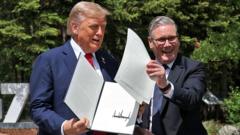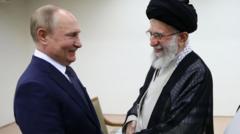In a dramatic escalation of tensions, President Trump has declared "total control" over Iranian airspace, calling for Iran's surrender as U.S. military movements signal potential involvement in conflict.
Trump Demands Iran's Surrender Amid Escalating Tensions

Trump Demands Iran's Surrender Amid Escalating Tensions
President Trump calls for Iran's "unconditional surrender" as military actions loom.
June 17, 2025, 8:15 p.m. ET
In a stark declaration on Tuesday, President Trump proclaimed that the U.S. has achieved “complete and total control of the skies over Iran.” This statement comes amidst increasing evidence that the United States may soon join Israel in a military campaign aimed at Iran. Trump’s comments, made via his social media platform before a scheduled meeting with his national security team, reflect a swift shift from optimism about a diplomatic resolution to a confrontational stance.
Long before the meeting commenced, the Pentagon took precautionary steps by dispatching approximately 30 refueling aircraft to Europe. These planes are poised to support American fighter jets stationed in the Middle East and potentially assist B-2 bombers in striking key targets in Iran, including the significant Fordo nuclear enrichment facility, constructed to endure heavy bombardment.
Trump's aggressive tone marks a significant pivot from his earlier assertions that a nuclear agreement with Iran was on the horizon. His unexpected decision to truncate participation in the Group of 7 summit in Canada, citing urgent matters in the Middle East, further illustrates the gravity of the situation. Speculations ripple through military circles regarding the deployment of the Massive Ordnance Penetrator, a formidable conventional bomb designed for deep penetration attacks, as a possible option for targeting Fordo.
While Trump proclaimed control over Iranian airspace, reports indicate that Israel remains the sole active combatant, utilizing U.S.-manufactured fighter jets to dismantle parts of Iran’s air defense infrastructure. Israeli military officials have communicated their achievements in neutralizing significant segments of these defenses, paving the way for potential further actions.
As the world watches closely, the implications of these statements and military movements thrust the U.S.-Iran relationship into a precarious and potentially volatile phase. Will diplomacy give way to open conflict? Time will tell.
In a stark declaration on Tuesday, President Trump proclaimed that the U.S. has achieved “complete and total control of the skies over Iran.” This statement comes amidst increasing evidence that the United States may soon join Israel in a military campaign aimed at Iran. Trump’s comments, made via his social media platform before a scheduled meeting with his national security team, reflect a swift shift from optimism about a diplomatic resolution to a confrontational stance.
Long before the meeting commenced, the Pentagon took precautionary steps by dispatching approximately 30 refueling aircraft to Europe. These planes are poised to support American fighter jets stationed in the Middle East and potentially assist B-2 bombers in striking key targets in Iran, including the significant Fordo nuclear enrichment facility, constructed to endure heavy bombardment.
Trump's aggressive tone marks a significant pivot from his earlier assertions that a nuclear agreement with Iran was on the horizon. His unexpected decision to truncate participation in the Group of 7 summit in Canada, citing urgent matters in the Middle East, further illustrates the gravity of the situation. Speculations ripple through military circles regarding the deployment of the Massive Ordnance Penetrator, a formidable conventional bomb designed for deep penetration attacks, as a possible option for targeting Fordo.
While Trump proclaimed control over Iranian airspace, reports indicate that Israel remains the sole active combatant, utilizing U.S.-manufactured fighter jets to dismantle parts of Iran’s air defense infrastructure. Israeli military officials have communicated their achievements in neutralizing significant segments of these defenses, paving the way for potential further actions.
As the world watches closely, the implications of these statements and military movements thrust the U.S.-Iran relationship into a precarious and potentially volatile phase. Will diplomacy give way to open conflict? Time will tell.





















